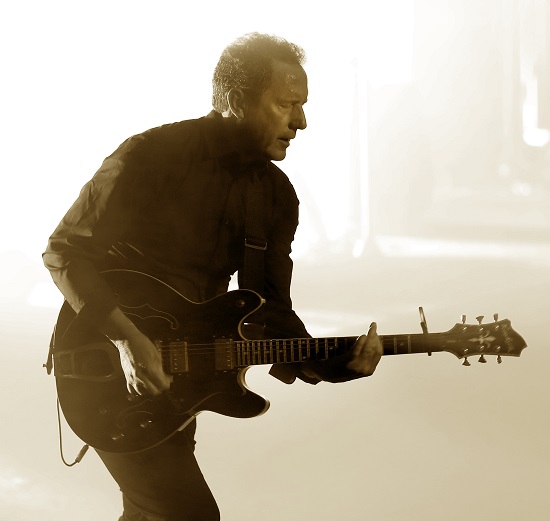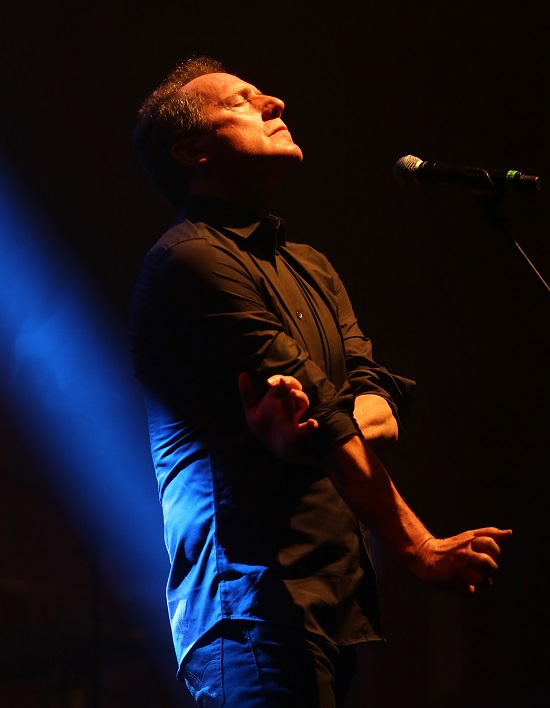“So, Paul Humphreys. Did you think back in 1976, in 3 Frankby Road, Meols, that we’d play this place?”
“Absolutely not. I didn’t think we’d play Eric’s.”
Back in 2005, the then-healthy All Tomorrow’s Parties introduced the concept of Classic Album Gigs to UK audiences with their Don’t Look Back series and the public’s appetite for a safe night of nostalgia hasn’t waned. This season at the Royal Albert Hall alone, you can catch Yes performing Fragile (1971) and Drama (1980), Manic Street Preachers playing two nights of Everything Must Go (1996), and Belle And Sebastian giving both Tigermilk and If You’re Feeling Sinister (1996) the treatment (as they also did for ATP once).
If it’s a been a long journey for Orchestral Manoeuvres In The Dark to take from the Wirral to the Albert Hall, for their fourth album Dazzle Ships the voyage from 1983 release to 2016 Classic Album status has been even more circuitous. As Luke Turner wrote on these pages, even in 2007 when OMD first embarked on the Classic Album tour circuit (playing their preceding hit album Architecture & Morality in full alongside plenty of fondly remembered singles), Dazzle Ships was left out in the cold, none of its tracks making their set-list.
“This is probably going to be the strangest, most esoteric collection of Orchestral Manoeuvres In The Dark songs you’ll ever hear in one show. I guess that’s why you came, huh?”
This selective history of the band wasn’t new either. Their big-selling, triple platinum 1988 greatest hits The Best Of OMD wiped Dazzle Ships’ twin singles ‘Genetic Engineering’ and ‘Telegraph’ from view too (unless you owned the CD version, which back in 1988 almost nobody did: CD players would remain luxury objects for a few more years to come). It wasn’t that Dazzle Ships lacked songs but that those it did include, among them some of the band’s strongest, were broken up by radio idents (‘Radio Prague’), speaking clocks (‘Time Zones’), sonar signals and obtuse electronic howls (the title track). As Bob Stanley noted in the Guardian, on its original release Dazzle Ships lost OMD 90% of their audience, selling a mere 300,000 compared to Architecture & Morality’s 3million. 300,000 is a healthy number today but in 1983 it shocked the band into pruning their experimental tendencies in favour of a transatlantic commercial sheen on the following year’s hit-stuffed Junk Culture.
For McCluskey at least, hit singles rather than album sales appear to be the yardstick for measuring OMD’s success, a point he alludes to whenever I’ve seen the group live. Even this evening, as Dazzle Ships is performed in full for the very first time, there’s the sense that his pride is still a little dented by its under-performing singles. The typewriter rhythm introducing ‘Genetic Engineering’ (which did reach #20 in the charts) is met with an affectionately intended “Only you lot would cheer for this song” while the high-energy ‘Radio Waves’ (which, if sales hadn’t dried up so quickly, would surely have been lifted as the album’s third single) is rewarded with a delighted “Well this never happened in 1983!” (“It definitely didn’t”, Humphreys adds).
It took 25 years, until the reception afforded to its 2008 expanded reissue, for OMD’s relationship with Dazzle Ships to thaw. Their 30th anniversary tour later that year began reintroducing its tracks into their set-lists, before their focus was drawn more closely back to the album in 2014 by the First World War centenary – the conflict in which the ‘dazzle’ camouflage which inspired the album title was used on Allied warships – and associated cultural events in Liverpool (including two OMD shows at the city’s Museum).
Even so, the group have launched Dazzle Ships into the Classic Album gig market with some caution. Tonight’s show was announced strictly as a one-off UK date and, while Dazzle Ships is prioritised in the promotion and merchandise, it’s been paired with the tried and tested idea of playing Architecture & Morality in full, in the second half of the evening. Furthermore, the accompanying graphic projections of previous OMD tours (the work of musician and filmmaker Hambi Haralambous) are absent this evening, replaced by a simple lighting rig.

Following an opening, tape-reliant sequence of ‘Dazzle Ship (Parts II, III & VII)’ and ‘Radio Prague’, it’s ‘ABC Auto-Industry’, with the whole band (McCluskey and Humphreys, plus long-term additional musician Martin Cooper and on-off drummer Stuart Kershaw) stage-front, making semaphore flag signals, which marks tonight’s sole concession to anything beyond standard concert performance. Marvellously, it brings a huge early roar from the crowd, McCluskey doubling-over with a joyful yell of appreciation, giving the group the nod that the show is going to work.
The notable one-off expense this evening is the on-the-night recording of the set by Live Here Now for one of those hastily burnt and assembled, post-show souvenir concert albums, a double-CD set whose gatefold A-Z of ‘every’ OMD song-title helps keep us awake on the train home, looking for omissions. According to a printed slip in the sleeve, “Unfortunately, there was a mistake at the printers and we are repressing the packaging with the correct colours” although it looks damn close to the shades of green and grey on my well-worn vinyl copy.
That costly looking original Dazzle Ships jacket may be another reason why its poor 1983 sales irked the band so. The story of how Peter Saville’s die-cut, floppy disc design for New Order’s ‘Blue Monday’ 12” lost money on every copy sold has been told so many times that the degree of truth involved has been frequently contested. With a Virgin Records budget and increased sales expectations for OMD, Dazzle Ships sees Saville and his design team taking the same year’s idea further and, one would imagine, to greater expense: three and a half die-cut holes in the front, many more concealed within the complex Time Zones image of the reverse gatefold, that vibrant semaphore flag inner.
More so than any other OMD sleeve, it’s the amount of detail that’s gone into the design of Dazzle Ships that helped it retain cult status throughout its decades in the wilderness of poor sales and critical loathing. For synth-pop besotted bedroom musicians like my friends, who, as late 80s schoolkids, followed our common ownership of The Best Of OMD (inevitably filed alongside New Order’s Substance 1987 and Pet Shop Boys’ Disco) by investigating the easily-obtained, always promising looking OMD records in the local flea markets, the instrument list on Dazzle Ships was the closest we could find to a shopping list. Roland Drumatix Rhythm Unit… Korg MS20… Roland SH09 & SH2… Speak And Spell Machine… we picked up what we could find, or the nearest approximate model (again, back when second-hand Korg, Moog and Roland gear was out of fashion and easily obtained. Looking back at the small fortune in vintage synths and drum machines we sold when half the band got into guitars a couple of years later is enough to make one weep).
Crucially to Dazzle Ships’ survival, we weren’t alone. In Penzance, bedroom musician Harvey Williams (who would record for Sarah Records as Another Sunny Day) recorded a fuzzy but faithful Portastudio cover of ‘Genetic Engineering’ (released on a 1989 7” by Bob Stanley’s Caff Corporation label). Across the water, Washington DC oddballs Eggs reinvented the same song on a 1994 7” on Teenbeat, with a sleeve that paid homage both to the Dazzle Ships inner and Saville’s artwork for New Order’s Movement. Back in Bexhill, our forever bedroom-confined band sampled ‘Dazzle Ships (Parts II, III & VII)’ and covered Architecture & Morality’s ‘She’s Leaving’ in full knowledge that doing so couldn’t make us any more uncool than we already were.
While the bare bones of OMD’s early work could be reasonably approximated by studio-less 80s wannabes, the best of the group’s material since reforming (on 2010’s History Of Modern and 2013’s English Electric albums) succeeds by harking back to those primitive sounds. Tonight, they break the concert’s ‘No songs after 1983’ rule with an encore of ‘History Of Modern (Part I)’ without breaking the nostalgic spell, its post-apocalyptic lyrics (“There will be no sun / When the final voice has gone”) as suited to the early 80s as the mid-2010s.

“Would you like to do some more dancing to 1980s Cold War geo-political songs?”
The arrangements of Dazzle Ships are barely tweaked, with the major exception of the speaking clock mini-symphony ‘Time Zones’, which comes newly overlaid with a heavenly, Kraftwerk-ian synth pattern and a collage of spoken word recordings (“Those who make peaceful revolution impossible make violent revolution inevitable”). The introductory tapes to ‘International’ are also revised and lengthened (“This is a planned crisis being used to smuggle ISIS into Western Nations”), updating the Cold War fears that informed the original album to mirror the continuing uncertainties of the post-War On Terror 21st century.
Andy McCluskey’s desire for hits drove a superficially shiny, happy version of OMD long into the 90s but, as he’s come to terms with his group’s ability to make accessible pop at an angle to the mainstream, so have OMD collectively come to terms with their failures as well as their successes. As the waves of adulation that greet their bigger singles tonight attest (not only Architecture & Morality’s hit trio of ‘Souvenir’, ‘Joan Of Arc’ and ‘Maid Of Orleans’ but also ‘Electricity’, ‘Messages’ and ‘Enola Gay’), Dazzle Ships is likely to remain too off the wall ever to permanently join the general public’s Classic Albums canon. Oddly, its rehabilitation now makes 1980’s great leap forward second album Organisation OMD’s more overlooked ‘lost classic’.
That’s the thing with canons. They’re impossible to destroy completely but, using all resources to the best of our ability, there’s always room to bend them at the edges.


